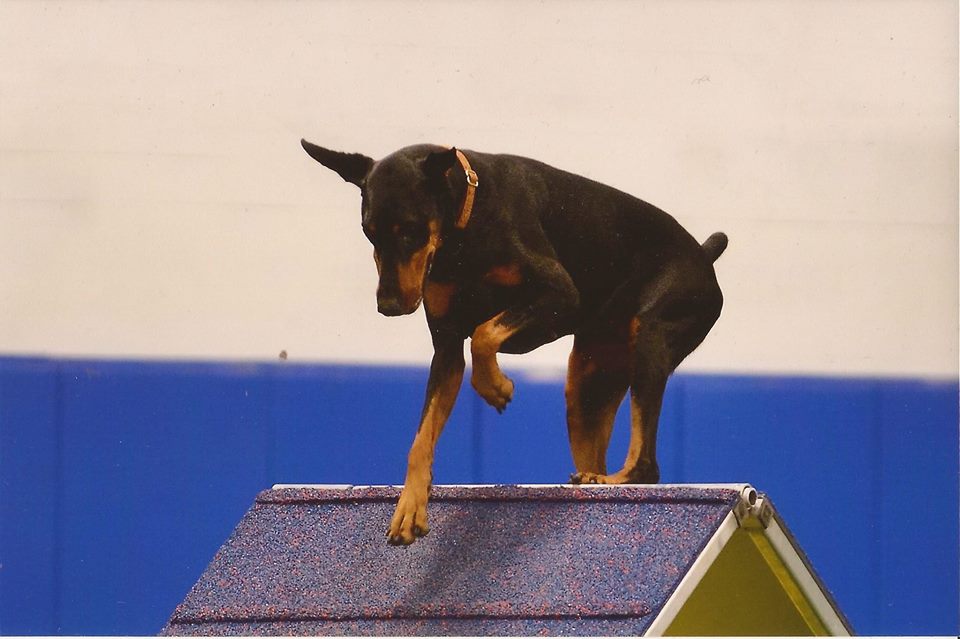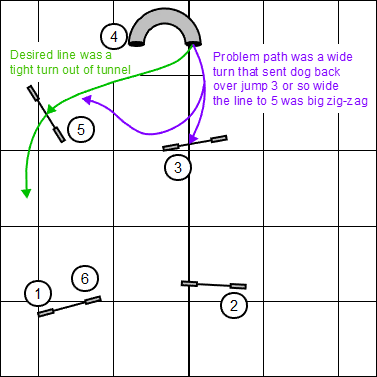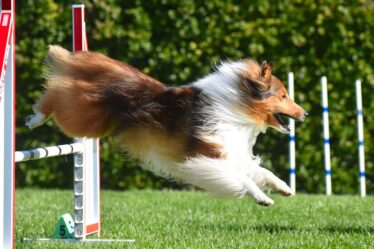
You already know before you instructor says it,
“You need to work on _______.”
Fill in the blank with any number of maintenance training issues from broken start-lines to popped weave poles.
Maintenance Training
Is for simple handling or obstacle issues that might cost you the Q or prevent you from training more challenging courses.
A common one is the dog walk-tunnel discrimination, which if you’ve trained recently, your dog listens for the cue/line correction on approach. But, if the discrimination has not been in practice, your dog may just barrel along on the current line without an ear twitch in your direction.
With young dogs these issues occur often as you two learn to communicate on course, but they happen also with more experienced dogs. For whatever reason, when a chronic obstacle or handling issue surfaces we have a “work on it” item.
Maintenance Issues
These are NOT training issues on your Magic 5 list, for which you build a complete training plan with multiple sessions over weeks or months to learn new skills or re-train behaviors.
These are obstacles, handling or developmental issues related to existing behaviors that have deteriorated or become unreliable. There are a few reasons a maintenance issues may appear.
A dog’s response to a cue can weaken from lack of reward or from handlers accepting variable criteria, which we all know happens too often in trial environments.
For example, after weeks of trialing with no rewards a once reliable “three jump lead out” kind of dog may break their stay before their owner can get past jump one. The dog isn’t being “naughty”; they need increased rewards for the correct criteria.
A soft spot or weakness can also happen from lack of use like the dog walk/tunnel discrimination or even overuse.
A good example of overuse is handling to the off-side entry to a C-tunnel. If you pull frequently to the off-side entry, then your dog may actually refuse a straight tunnel cue or just take the off-course assuming all C-tunnels are off-side entries. Dogs do learn obstacle patterns and then may ignore handling cues.
Planning for Maintenance
This past weekend I found a weak spot, a way too wide turn, while running an AKC master jumpers course with my young sheltie, Zabu. If the dog turned tight out of the C-tunnel, then the dog’s line was set to jump 5 (green path). If the dog turned wide, there were two problems: a back jump over jump 3 OR a zig-zag line to jump 5 which often caused the bar to come down.

My older dog turn tight on cue, but Zabu swung wide out of the tunnel despite my verbal cue. A weak spot like this doesn’t require a full 6 week training plan. It just needs to be “worked on”, but how exactly does that happen?
With maintenance issues, I am not doing a retrain or developing a new skill. I am reinforcing an existing skill. It is important to know and separate the two. However, I still take time to go back through the skill’s development. This helps me stay consistent in my training process.
To break this down, I look at the following:
The cue I use needs to be consistent. For a tight tunnel turn, I use a simple verbal “Tunnel Come” which tells my dogs to turn tight. Whereas “Tun Tun Tun” tells them to go forward after a tunnel. Cue timing matters; my dog needs time to process my cue and initiate the desired behavior.
The behavior I want is a very tight turn out of the tunnel which means he looks for me immediately, rather than taking a stride forward before turning. So, I will click/mark only those turns where I see my dog’s eyes looking for me as he exits the tunnel. This reinforces his first stride after the tunnel is an efficient turn.
The reward will be on the tight line and will vary between a baited target and a tossed toy.
A fundamental rule in animal training = rewarded behaviors get repeat. With a behavior that needs maintenance, I plan three training sessions with three different objectives to reinforce the behavior.
Session #1 – isolate the behavior
Session #2 – put the behavior in a simple sequence
Session #3 – do a harder sequence that allows generalization and comparison to an alternative behavior.
Each session will have 3-5 reps.
I only progress to the next session if the dog has a high success rate, particularly on the first few repetitions. If the behavior is consistent only at the end of the session, then the weak behavior needs to repeat that session.
Only if your dog is successful does an increased frequency of rewards improve your dog’s competence and confidence in completing the cued behavior. Trust me, it’s worth spending the extra time and treats reinforcing the criteria you want to see on course.
I also pay attention to other factors that can impact my dog’s ability to complete the cued behavior.
For example, my dog might perform a behavior better on my left side or right side. The environment can also influence my dog’s performance; including distractions, the footing and equipment. To help, training sessions should be in various locations and spread out over a week or two.
With continued training my dog should have an improved understanding of the cue and behavior. Their success rate when completing the behavior should be between 90-100%.
More Training Tips
With your own training field maintenance training is easy. But, too often handlers are using course layouts in a rented space or can only train in a weekly class. To avoid just randomly throwing in a reward during “training” without having an exact plan, I have two suggestions.
1. Do your maintenance as a warm-up.
This is easy to do with tunnel issues, contact criteria or when shoring up your dog’s response to a handling cue. In a warm-up situation, you can focus easily on one simple cue-behavior-reward pattern and can get multiple repetitions done quickly.
2. Ask your instructor to help.
This is your training time, and most instructors are glad to help you train something specific, particularly if they asked you to “work on it”! Ask them to help you with your maintenance issues.
For example, instead of running the full course, ask to run a smaller section to allow you to reward where needed. You could quietly ask for an alternate path for your dog for one turn. You might also ask for an extra minute or two at the end of a class for a few minutes of training time on a maintenance issue. You are training a simple behavior just a few good rewards will benefit your dog.


